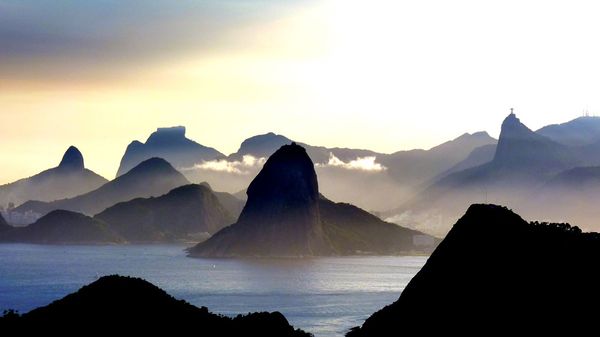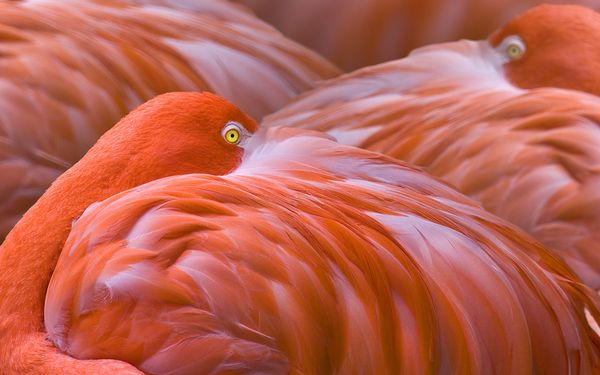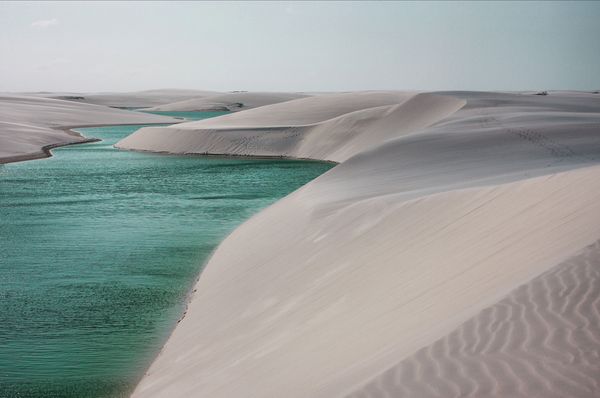Brazil
The world’s 5th-largest country has an astounding array of natural and cultural wonders. Like Australia, Brazil may just have everything you are looking for with soulful coastal cities, wildlife-filled rainforests and UNESCO World Heritage sites; Dali-esque national parks with sand-dune capes and crystal clear waters; historic North-Eastern cities that hum to the beat of Afro-Brazilian rhythms or get wet snorkeling through undersea wonders off reef-fringed islands; canoeing down the Amazon; admiring the awe-inspiring thunderous waterfalls, or the scenic Pantanal wetlands that resemble nowhere else on Earth.
With such diverse experiences and activities all via for your attention in the vast Brazilian landscape, it is proving difficult to plan and decide on a set itinerary.
Here are some highlights so far:
Po De Aucar, Rio De Janeiro
Seen from the peak of Po de Aucar (Sugarloaf Mountain), Rio is arguably the most beautiful city in the world. There are many good times to make the ascent, but sunset on a clear day is apparently the most rewarding.
A visit to Po de Aucar is a must, but if you can, avoid it from about 10am to 11am and 2pm to 3pm, when most tourist buses arrive. Avoid cloudy days as well. Two cable cars connect to the summit, 396m above Rio. The first ascends 220m to Morro da Urca. The second cable car goes up to Po de Aucar. The two-stage cable cars depart every 30 minutes.
Pantanal
Though the Amazon has the glamour, it is the Pantanal that is said to shine as Brazil’s top destination for wildlife-viewing and birdwatching. It makes up one of the most important and fragile ecosystems on the planet and is home to an impressive concentration of animals. Jaguars, caimans, anacondas, giant otters and capybaras are here in great numbers, as are seemingly endless collections of extraordinary birds, including macaws, toucans and jabiru storks.
The world’s largest wetland is some 210,000sq km. Less than 100,000sq km of this is in Bolivia and Paraguay; the rest is in Brazil.
Iguazu Falls
My mother’s favourite place on earth, she has long told about the ultimate natural spectacle that is the Iguazu Falls. A total of 275 individual falls occupy an area more than 3km wide and 80m high, which makes them wider than Victoria, higher than Niagara and more beautiful than either.
Luring visitors with its first tier of cascades, it does not disappoint and continues to dazzle them with a seemingly endless theatre of tumbling water. The power and the splendour of Iguazu Falls have always earned the awe and admiration of travellers, from indigenous tribes to Jesuit missionaries to modern-day tourists. In 1986 UNESCO declared the region a World Heritage site.
Rio’s nightlife
No place quite captures the soul of Rio de Janeiro as does Lapa, Brazil’s most musically charged neighbourhood, with dozens of music clubs, bars and old-fashioned restaurants along its avenues.
On weekend nights, revellers pack the neighbourhood’s samba clubs, its streets and the wide plaza in front of the Arcos do Lapa, the neighbourhood’s prominent landmark. Mixing on the cracked sidewalks and battered back lanes are all sorts: rich and poor, straight and gay, pimps and prostitutes, malandros (con artists), musicians, artists, gringos and the sundry characters that have long called Lapa home.
Carnaval, Rio De Janeiro
One of the world’s largest parties, Carnaval is celebrated with verve in practically every town and city in Brazil. Although ostensibly just five days of revelry, from the Friday to the Tuesday preceding Ash Wednesday, the festivities can begin weeks in advance as is the case in Rio.
I am sure you have heard by now, Rio throws an unrivaled party, with distinctly Brazilian rhythms and dancing filling the streets for days on end. The culmination of the festival is the brilliantly colourful parade through the Sambodromo, with giant mechanised floats, pounding drummers and whirling dancers.
For those seeking more than just the stadium experience, there’s lots of action in Rio’s many neighbourhoods, although be sure to read your travel warnings, try and party in small groups and be cautious of your personal items and safety.
Parque Nacional Da Chapada Dos Guimares
Only receiving national park status in 1989, the outstanding Parque Nacional da Chapada dos Guimares remains a tad under the radar in the context of Brazil’s most impressive national parks.
The two exceptional sights inside the park are the Veu de Noiva falls and the Cidade de Pedra (Stone City).
Hopefully, it will stay that way as its offerings are as spectacular as anything in Brazil, you usually won’t have to share them with anyone. There is a visitors centre at the park entrance, but note that access to the attractions is controlled to avoid congestion. Try to visit during the week when it is quietest.
The Pelourinho, Salvador
The Pelourinho (or Pelo) is the heart of Salvador’s nightlife and tourism, and a UNESCO World Heritage site of magnificent churches and colourful colonial buildings.
Wandering the narrow streets, stumbling over cobblestones and gazing up at the city’s oldest architecture, you’ll feel the ages of music; dance and capoeira shape the pastel-coloured 17th and 18th-century buildings.
Pelo has undergone major restoration work, which admittedly, has made it lose a lot of its old-world character but the area is now safer, better preserved and remains an architect’s wonderland, thanks to ongoing work funded by UNESCO since 1993.
Ouro Preto
Ouro Preto is the jewel in the crown, of all the exquisite colonial towns scattered around Minas Gerais. Built at the feet of the Serra do Espinhao, Ouro Preto’s colonial centre is larger and has steeper topography than any other historical town in Minas.
Navigating the vertiginous cobblestone slopes on foot can be exhausting, but the views of 23 churches spread out across the hilly panorama are spectacular.
Brazil’s 3rd most visited tourist destination, Ouro Preto was historically a centre of gold mining and government, and was the stage for Brazil’s first independence movement, the city remains vital in modern times as a centre for education and the arts.
Paraty
Set amid jutting peninsulas and secluded beaches, with a backdrop of steep, jungled mountains plunging into an island-studded bay, Paraty is one of Brazil’s most appealing and exquisitely preserved historical gems.
Paraty’s colonial centre holds abundant charm not only because of its centuries-old architecture but it has managed to minimize automobile traffic. The irregular cobblestone streets are closed to motor vehicles, making it a delightful place to explore on foot. Elegant white buildings adorned with fanciful multihued borders and latticed windows blend harmoniously with the natural beauty that envelops the town. Paraty is only a few hours away from dozens of pristine beaches that are accessible by boat or bus.
Lenois Maranhenses (Free admission)
The name of this national park refers to its immense expanses of dunes, which look like lenois (bed sheets) strewn across the landscape and stretch 70km along the coast and up to 50km inland. Halfway between So Luis and the Piaui border, the park also includes beaches, mangroves, lagoons and some interesting fauna, especially turtles and migratory birds.
The area’s designation as a national park in 1981 staved off potentially ruinous land and oil speculation. It’s spectacular, especially from March to September when rain that has filtered through the sand forms crystal-clear pools and lakes between the dunes.
Feel free to share your experiences and suggestions. Love to hear your suggestions!


